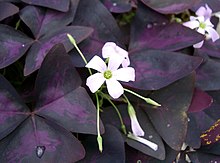Oxalis triangularis
| Oxalis triangularis | |
|---|---|

| |
| Scientific classification | |
| Kingdom: | Plantae |
| Clade: | Tracheophytes |
| Clade: | Angiosperms |
| Clade: | Eudicots |
| Clade: | Rosids |
| Order: | Oxalidales |
| Family: | Oxalidaceae |
| Genus: | Oxalis |
| Species: | O. triangularis
|
| Binomial name | |
| Oxalis triangularis | |
| Synonyms | |
|
Oxalis regnellii | |

Oxalis triangularis, commonly called false shamrock, is a species of
The deep maroon leaves are
Description
Growing to 50 cm (20 in) tall and broad, the
The five densely haired
Movement
The leaves of O. triangularis move in response to
Range
The species is distributed in several countries of South America: Brazil, Bolivia, Argentina and Paraguay. It is a neophyte in the United States in the states of Florida and Louisiana. It is also widely found in East India abundantly in states like Nagaland and Manipur.
Cultivation and life cycle

O. triangularis requires bright indirect sunlight supplemented with a cool indoor temperature of 15 °C (59 °F). It can tolerate higher indoor temperatures but will go into dormancy prematurely and/or begin to take on a "tired" appearance if temperatures exceed 27 °C (81 °F) for prolonged periods of time. It thrives in an average potting soil with good drainage.
Mature plants are cut back to the soil every 3–5 years in early summer or during the dormancy period. Young plants are cut back to the soil every year in early summer or during the dormancy period, until they reach maturity. Fearing frost, they are usually grown indoors. They are planted in soil rich in humus and well drained. They should be watered only when the topsoil looks dry. In winter, they should not be watered.[3] The main difficulty in caring for frost-resistant oxalises is to prevent them from growing uncontrollably.[4] The ripe fruit of the plant will crack, throwing away seeds over a considerable distance, so do not plant the oxalis close to vegetable beds. Oxalis need no fertilizer before flowering. Afterwards it can be fertilised with an appropriate fertiliser. Plants usually only need nitrogen whereas phosphorus, potassium and easily absorbed trace elements help them to flower long and beautifully.[5] When growing in a flowerbed,[6] it is also worth feeding oxalis during the flowering period with a small dose of a multi-component fertiliser.[7]
The subspecies Oxalis triangularis subsp papilionacea has won the Royal Horticultural Society's Award of Garden Merit.[8]
Usage
The leaves are eaten raw or cooked and have an acidic taste due to their
Propagation
Oxalis triangularis grows from
References
- ^ "RHS Plantfinder - Oxalis triangularis subsp. papilionacea". Retrieved 16 April 2018.
- ^ Guy L. Nesom: Taxonomic notes on acaculate oxalis (Oxalidaceae) in the United States. In: Phytologia, Volume 91, Issue 3, December 2009.
- ^ Flora of Peru (Volume 2) . In: J. Francis Macbride (ed.): Botanical Series . Volume III, No. 2 . Publication (Field Museum of Natural History), Chicago 1949, pp. 83-84
- ^ "Five Reasons it's Okay to Love Oxalis – and Stop Poisoning It". sfforest.org. 12 May 2015. Retrieved 2022-11-08.
- ^ "How to Grow and Care for Purple Shamrock (False Shamrock)". thespruce.com. Retrieved 2022-11-08.
- ^ "How to Grow, Repot, and Care For Oxalis Triangularis (False Shamrock)". enterneverland.com. Retrieved 2022-11-08.
- ^ "Oxalis control". hgic.clemson.edu. Retrieved 2022-11-08.
- ^ "Oxalis triangularis subsp. papilionacea". RHS. Retrieved 18 January 2021.
- ^ "Oxalis regnellii atropurpurea - Purple Shamrock". Plant of the week. Archived from the original on 2011-08-11. Retrieved 2011-06-01.
External links
- "Oxalis triangularis". GardenWeb.
- 2007 IUCN Red List of Threatened Species[dead link] (for conservation status)
- Zimmerman, Maureen Williams. Sunset House Plants A to Z: How to Choose, Grow and Display Sunset Publishing Corp. 1998. ISBN 0-376-03337-1
